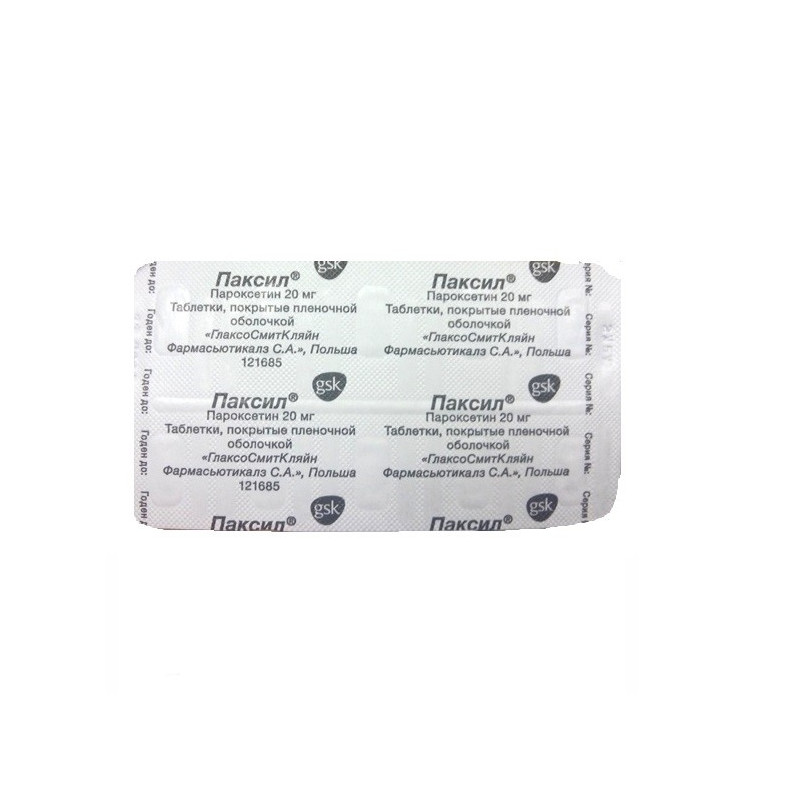



 All payments are encrypted via SSL
All payments are encrypted via SSL
 Full Refund if you haven't received your order
Full Refund if you haven't received your order
- Depression of all types, including reactive depression, severe endogenous depression, and depression accompanied by anxiety (results of studies in which patients received the drug for 1 year show that it is effective in preventing recurrence of depression).
- Treatment (incl.supportive and prophylactic therapy) of obsessive-compulsive disorder (OCD) in adults, as well as in children and adolescents aged 7-17 years (it has been proven that the drug is effective in treating OCD for at least 1 year and in preventing relapse of OCD).
- Treatment (including supportive and prophylactic therapy) of panic disorder with and agoraphobia (the efficacy of the drug lasts for 1 year, preventing recurrence of panic disorder).
- Treatment (including supportive and prophylactic therapy) of social phobia in adults, as well as in children and adolescents aged 8-17 years (the effectiveness of the drug persists with long-term treatment of this disorder).
- Treatment (including supportive and prophylactic therapy) of generalized anxiety disorder (the efficacy of the drug remains with long-term treatment of this disorder, preventing relapse of this disorder).
- Treatment of post-traumatic stress disorder.
- Simultaneous administration of MAO inhibitors and a period of 14 days after their withdrawal (MAO inhibitors should not be prescribed for 14 days after the end of treatment with paroxetine).
- Simultaneous administration of thioridazine.
- Hypersensitivity to paroxetine and other components of the drug.
In experimental studies, no teratogenic or embryotoxic action of paroxetine was detected.Data on a small number of women who took paroxetine during pregnancy indicate the absence of an increased risk of congenital anomalies in the newborn. There are reports of preterm labor in women who received paroxetine during pregnancy, however, a causal relationship with taking the drug has not been established. Paxil should not be used during pregnancy, unless the potential benefits of treatment outweigh the possible risks associated with taking the drug.
It is necessary to monitor the health status of newborns whose mothers took paroxetine in late pregnancy, since there are reports of complications in children (however, a causal relationship with taking the drug has not been established). Respiratory distress syndrome, cyanosis, apnea, seizures, temperature instability, feeding difficulties, vomiting, hypoglycemia, arterial hyper- or hypotension, hyperreflexia, tremor, irritability, lethargy, constant crying, drowsiness are described. In some reports, symptoms have been described as neonatal manifestations of withdrawal syndrome. In most cases, the described complications occurred immediately after childbirth or soon after it (within 24 hours). Paroxetine in small quantities is excreted in breast milk. Therefore, you should not use the drug during lactation, except in cases where the potential benefits of treatment outweigh the possible risk associated with taking the drug.
Inside, in the morning - 20 mg.With insufficient effect, an increase in dose by 10 mg / day with an interval of at least 1 week is possible (the maximum dose is 50 mg / day). In elderly, malnourished patients, as well as in violation of kidney and liver function, the initial dose is 10 mg / day, the maximum is 40 mg / day.
Drowsiness or insomnia, tremor, nervousness, increased excitability of the central nervous system, impaired concentration, emotional lability, amnesia, dizziness, paresis of accommodation, pupil dilation, eye pain, noise and pain in the ears, increased or decreased blood pressure, fainting, tachycardia or bradycardia, violation of cardiac conduction and peripheral blood circulation, cough, rhinitis, dipnea, tachypnea, nausea, loss of appetite, dyspepsia, increased activity of hepatic transaminases, stomatitis, arthralgia, arthritis, dysuria, polyuria, non-contained e incontinence, urinary retention, amenorrhea, dysmenorrhea, miscarriage, mastitis, abnormal ejaculation, decreased libido and potency, peripheral edema, decrease or increase of body weight, anemia, leukopenia, allergic reactions (pruritus, urticaria, chills). Seldom - thought disorder, akinesia, ataxia, seizures, hallucinations, hyperkinesia, manic or paranoid reactions, delirium, euphoria, grand mal seizures, aggressiveness, nystagmus, stupor, autism, decreased visual acuity, cataracts, conjunctivitis, glaucoma, exophthalmos, angina, myocardial infarction, cerebrovascular accident, cardiac arrhythmias, eosinophilia, leukocytosis, lymphocytosis, monocytosis, hematuria, nephrorolithiasis, renal dysfunction, dermatitis, erythema nodosum, depigmentation.
It should be taken with caution in renal and hepatic insufficiency, angle-closure glaucoma, prostatic hyperplasia, mania, cardiac pathology, epilepsy, convulsive states, in combination with electropulse therapy, in patients receiving drugs that increase the risk of bleeding, with risk factors for increased bleeding. During treatment, you must refrain from taking alcoholic beverages. Use with caution while working drivers of vehicles and people whose profession is associated with increased concentration of attention. When abruptly canceled - dizziness, sensory disturbances, sleep disturbance, agitation, anxiety, nausea, sweating. Care should be taken when prescribing in combination with lithium preparations. At the time of treatment should refrain from the use of ethanol.
Inductors of microsomal oxidation (phenobarbital, phenytoin) reduce blood concentration and activity, inhibitors (cimetidine) - increase. Increases procyclidine levels in plasma. Incompatible with MAO inhibitors. Joint appointment with indirect anticoagulants can cause increased bleeding at an unchanged amount of prothrombin time. Enhances the effect of alcohol.
Available information on paroxetine overdose suggests a wide range of safety.
Symptoms: increased side effects described above, vomiting, dilated pupils, fever, changes in blood pressure, involuntary muscle contractions, agitation, anxiety, tachycardia.
Patients usually do not develop serious complications even with a single dose of up to 2 g of paroxetine. In some cases, coma and changes in the EEG develop, very rarely there is a lethal outcome with the combined use of paroxetine with psychotropic drugs or alcohol.
Treatment: standard measures used in the overdose of antidepressants (gastric lavage through artificial vomiting, the appointment of 20-30 mg of Activated carbon every 4-6 hours during the first days after the overdose). The specific antidote is unknown. Showing supportive therapy and control of vital body functions.
Store in a dry place at a temperature not exceeding 30 °.
Paxil